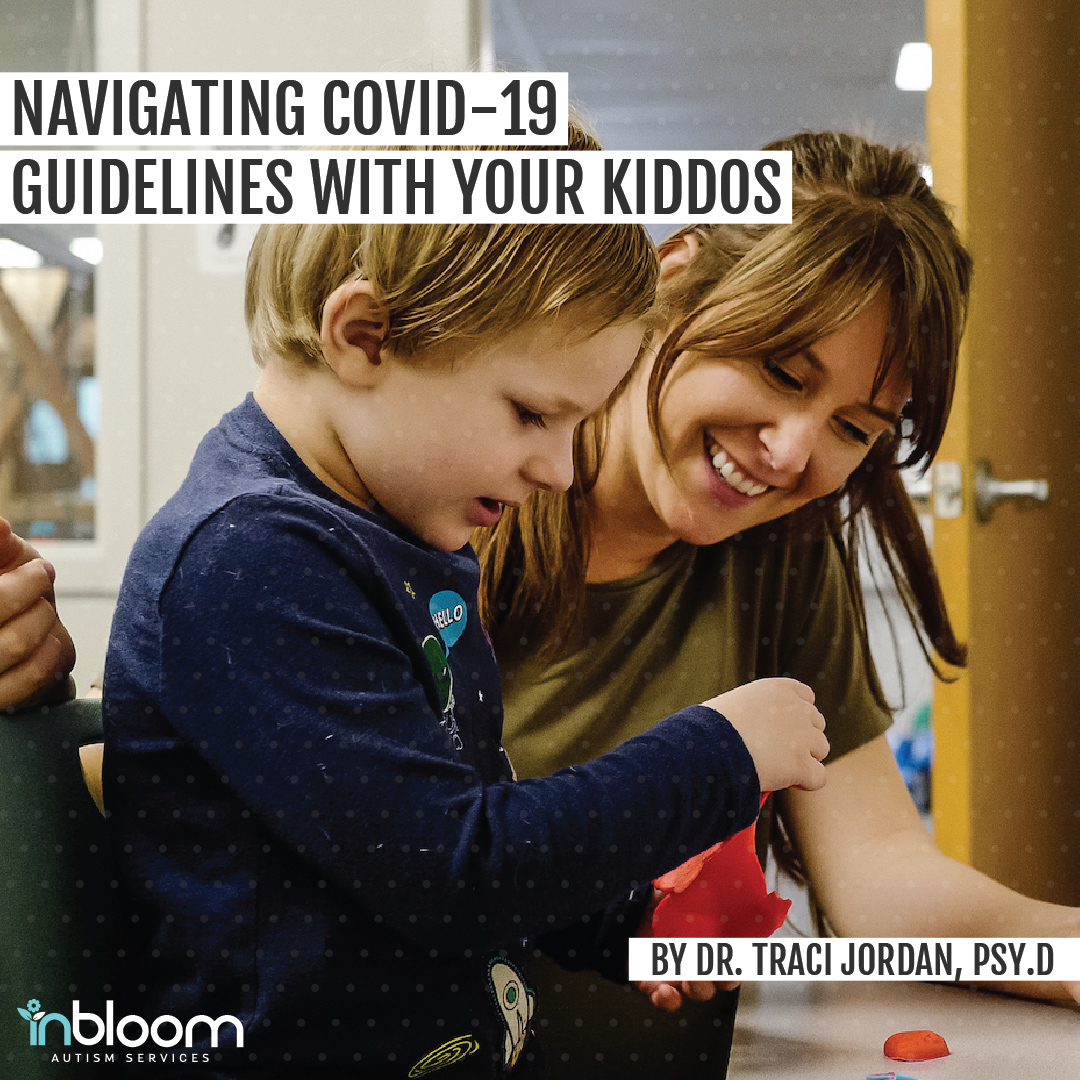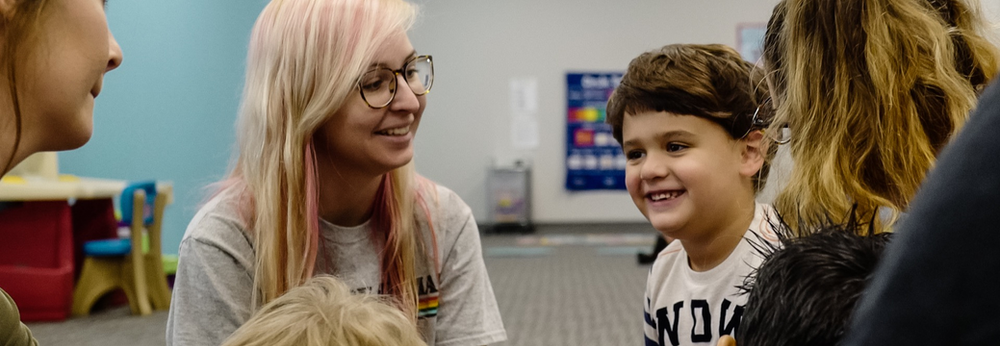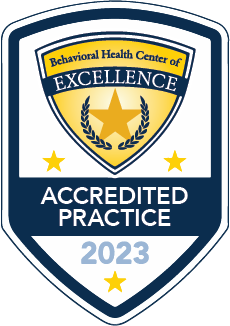NAVIGATING COVID-19 GUIDELINES WITH YOUR KIDDO

Decades ago a prominent physician, Hans Selye, famously defined stress, not as inherently positive or negative, but as simply a demand on humans to adapt to change. By that definition, stress equals change. With COVID-19 conditions constantly forcing parents to adapt to incoming information and rapidly changing demands, whether we are sequestering at our homes or are out in our community, one thing is certain, parent stress levels are high. We all need increased support from partners, friends and family as we struggle to keep up with the many changes in COVID-19 guidelines and information overload.
Our kiddos are also facing stressful changes during this health crisis, such as physical distance rules, separation from friends, and restrictions on outdoor play. The difference is that, unlike parents, our kiddos often lack the maturational ability to verbalize their stressful emotions. Although these changes pose challenges for all children, kiddos on the spectrum are more vulnerable to extreme reactions when faced with change, primarily because of core features associated with ASD:
- Many children on the spectrum have trouble comprehending their own or other people’s feelings. Without words to label their feelings, they may express feelings through tantrums or, if your child is extra sensitive, by tuning parents out.
- Many children on the spectrum struggle to initiate and maintain social relationships, and benefit from supervised opportunities to practice such skills. When they are forced to sequester because of the pandemic, potentially rewarding socialization practices, such as play dates, are postponed.
- Many children on the spectrum are easily overstimulated and show an insistence on sameness and a strong desire to follow familiar routines. This need for predictability may make the adaptation to major changes that are necessitated by sequestering, such as separation from a favorite teacher or sitter, particularly distressful.
Unlike parents, our kiddos often lack the maturational ability to verbalize their stressful emotions.
How can we provide our kiddos on the spectrum with needed emotional and social support during these trying times?

Keeping up with your child’s on-line schooling and therapy can help you encourage their adaption to on-line routines. Keep all recommended virtual therapy appointments and ask the therapist questions. Read all the school communications, and talk with your kiddo’s teacher about how you can work together to help your child do their best.
Plan for major changes. It’s’ not too early to start to plan the transition to school in the fall by making bedtime a little earlier each week. Read books about starting school, such as Maisy Goes to Preschool, by Lucy Cousins. Make a game out of practicing important self-help skills, such as unwrapping a snack. If your child’s school classroom will be online, you might try to play out the school routine with dolls.
Maximize our child’s school resources. Staying connected with your child’s school will ensure that you Identify additional school resources, such as whether your school or district is providing meals, or technology, such as laptops and tablets. If you have not already, this might be the time to schedule a meeting with your kiddo’s teacher or counselor and consider whether they might benefit from an Individual Education Program (IEP).
Every kiddo is unique and parents are the best judges of what their child with ASD is ready to take on.
Children on the spectrum do best when they are prepared for changes, both long term and short-term, and they benefit from warnings prior to inevitable transitions. Start small and focus on teaching them one thing at a time, such as how to give people outside the family more physical space. Consider writing a physical distance social story about what your kiddo can expect about distancing when out in public. Keep it short and simple. Focus on one change, such as respecting physical boundaries, at a time.
Provide clear expectations, demonstrations, and specific behavioral guidelines when going out in public. Every kiddo is unique and parents are the best judges of what their child with ASD is ready to take on. For some children, community activities need to be short to avoid sensory overload. Restate familiar messages before leaving home, such as, “We are not getting close to people outside our home to keep ourselves and others safe.”
Focus on the positive. Just like anyone else, kiddos with autism spectrum disorder respond well to praise and other positives. Catch them being good, praise them for behaviors you want to see more often, and respond to less desirable behaviors in a supportive manner (teach them what to do, rather than what not to do). Encourage them to use words for their feelings or even to draw their feelings. Focus on breathing and other simple calming exercises. Re-assure them that, “parents are working hard to keep you safe” Health routines, such as washing hands to “Twinkle Twinkle,” gives children a sense of what they can control.
Stay consistent and on schedule. Just like other children, kiddos with ASD often have difficulty adapting to change and do best when they know what to expect. A fun colorful calendar may provide a visual of the new daily routines. If they are older, allow them to participate in decisions about schedules and chores. Of course, since real life is NOT always going to be perfectly consistent and ALWAYS on schedule, consider planning a small change in the schedule each day to teach your child to handle change. This might be as simple as shaking up the order of your bedroom routine, or planning to stay up a half-hour later to watch a favorite show.
Be prepared to give it time; our kiddos on the spectrum will adjust to this new normal. You may try out different techniques for teaching health routines as you determine what works best for your kiddo. Some may do best with simple calming exercises, such as a focus on breathing. Others may need more physical outlets for their energy, such as dance and playing.
Your child’s therapist and teachers can also provide understanding and ideas for helping your child make a positive adjustment to the crisis.
Put play on your schedule. Use fun, playful strategies paired with lots of positive reinforcement. Find activities that seem like pure pleasure, and not more education, to channel stress. Spend special time together every day giving them your full attention, even if it’s just for a few minutes, to enjoy fun, relaxing activities, such as finger painting and playdoh, as a way to release stressful feelings.
Finally, you are not alone and you don’t have to do it alone. Local support groups for parents who share similar parenting challenges are terrific sources of reassurance and information. Connect with state and national support groups, such as Autism Speaks, to gain access to a wealth of resources. Your child’s therapist and teachers can also provide understanding and ideas for helping your child make a positive adjustment to the crisis. If grandparents and/or sitters are not available because of COVID-19, and you have a partner at home, alternate child care duties to give yourself some private time. Checking your guilt at the door, journey inward, even if for 20 minutes, during your child’s naptime or before they wake for the day. If you are flying solo, you need to find a personal oasis within your home. Whether indulging in a tranquil bubble bath, a zoom chat with a friend, or meditation, taking care of yourself is paramount to your child’s well-being. To paraphrase the old airline adage, we must first put on our own mask before we can help our children and others.
ABOUT THE AUTHOR

DR. TRACI JORDAN, Psy.D., L.S.S.P.
Dr. Traci Jordan, Psy.D., L.S.S.P. holds a dual license in clinical and school psychology, and has assessment experience with a wide range of developmental, cognitive, psychological problems and challenges. She has a lifelong passion for child development and family systems, completing pre and postdoctoral training in child clinical and developmental pediatrics before opening a private practice focused on child assessment and treatment. She draws on her 30 years of experience in assessment and research methods to develop and teach a core graduate level class in psychodiagnostics through the Department of Educational Counseling of Texas A&M Corpus Christi. She is an advocate for animal rights, volunteering as a sponsor and foster for a local canine rescue organization. Yoga, family, friends, and pets keep her centered.


